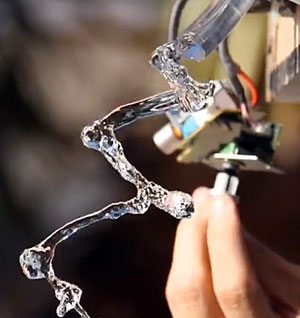This magical water physics demonstration shows how the stroboscopic effect works (VIDEO)
posted Wednesday, March 13, 2013 at 3:50 PM EST

This video (below) from science and illusion explainer brusspup looks all but magical. He shows a moving stream of water, frozen in mid-air in a waveform that seems to be suspended no matter how he moves around it. But it’s a straightforward scientific explanation that also demonstrates a classic illusion seen in many movies: the stroboscopic or wagon-wheel effect.
Brusspup runs a water hose over a speaker, with a few inches hanging off the bottom, and then plays a sound at a specific frequency through the speaker. This causes the hose (and the water inside it) to vibrate at that frequency. In this case, he’s got the sound playing at 24Hz, which he then pairs with a camera recording at the same frequency: 24fps. Since the water and hose are moving at the same frequency as the camera records, they appear to be frozen in space, at the same point in the waveform for each frame the video captures. Brusspup then makes the water stream appear to move forwards and backwards, by tweaking the frequency in either direction.
What’s curious is that this illusion wouldn’t occur to the naked eye, it depends on the camera recording at the right frame-rate to capture the effect. In real life, it would just be a hose splattering water everywhere. The effect could work at any camera speed, as long as you match it to the sound frequency, you could just as easily do it at 60fps/60Hz or 30fps/30Hz. What you see is a demonstration of the wagon-wheel effect. If you’ve ever watched a movie, and wondered why a helicopter’s blades or a wheel’s spokes seem to be stationary or moving backwards, it’s the same thing. The speed of motion coincides, or is slightly out of sync, with the film speed and so causes things to look like they’re not moving, or are doing so slowly.
While this experiment wouldn’t look particularly impressive in real life, it does make for an intriguing video. Frankly, it’s not one that would be too hard to replicate, so if you have a bright sunny day, a big speaker, and sound wave generating software, you could probably put the whole rig together in your backyard pretty easily. Just make sure you have a fast enough shutter speed on your video, or else you won't be able to see the effect, and the water will end up looking a smeared mess.
(Via Reddit)